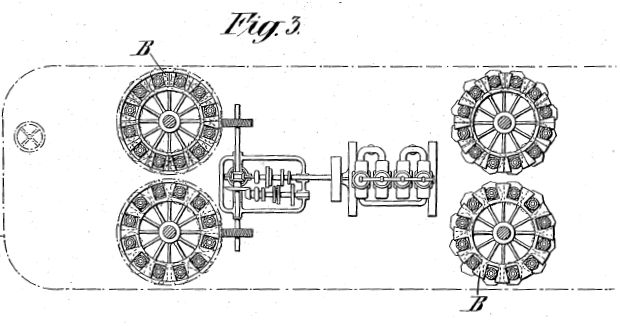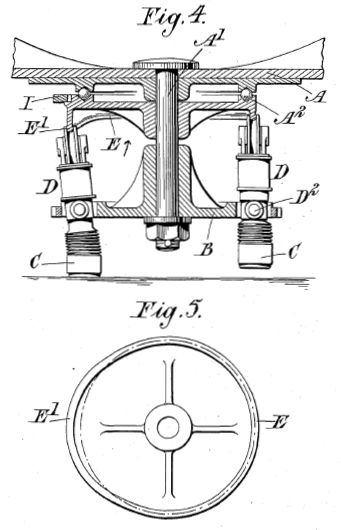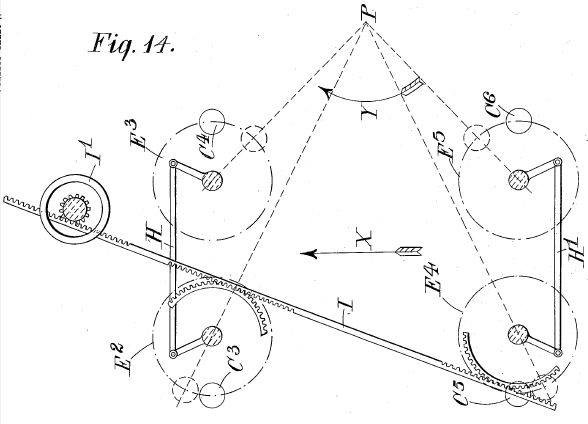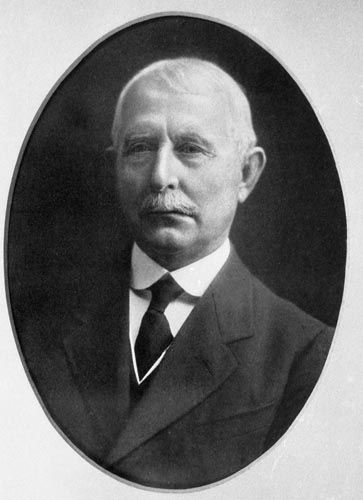
Patent number: 880526 – see full patent details here.
Filing date: Jun 27, 1907
Issue date: Mar 3, 1908

A very ingenious walking wheel mechanism was invented by the British inventor H. S. Hele-Shaw. He was inspired by another British invention, Diplock's Pedrail and heavily promoted the Pedrail before inventing his own variation.
The carriage is supported on legs attached to four wheels which have vertical axes, not the normal horizontal axes (Fig. 4 and 5).

Fixed cams drive the legs downwards to touch the ground at the outside of the circle as the wheels rotate, so that by driving the wheels on the two sides in the opposite direction the carriage is propelled.

It can be steered (Fig. 14) by suitably rotating the four cams to give a differential action; thus a fully four-wheel steering is obtained.

Dr Henry Selby Hele-Shaw (1854-1941)
(Sourced from here )
Henry Selby Hele-Shaw was born in Billericay, Essex, in 1854. He was educated privately, and at the age of 17 he was articled to firm of Roach and Leaker at the Mardyke Engineering Works, Bristol. After completing his apprenticeship in 1876 he gained the Senior Whitworth Scholarship, which enabled him to study at the University of Bristol. He also gained various Whitworth Prizes during the course of his study, which helped him become appointed assistant to the Professor of mathematics and engineering.
He was promoted to be first professor of engineering at the University of Bristol in 1880, but left four years later to take up the Harrison Chair as first professor of engineering at Liverpool University College. He worked hard to set up the engineering faculty on a more permanent basis, and was instrumental in setting up and equipping the Walker Engineering Laboratories.
It was in Liverpool that he carried out his famous experiments in the streamline flow of liquids, based on investigations of liquid flow between parallel glass plates. In 1899 he was elected a Fellow of the Royal Society for this work.
This work led to the development of the wet clutch used in automobiles and heavy industry.
Shortly after relinquishing his position at the University of Liverpool in order to spend more time on consulting work, and the development of his own inventions, he began to devote his attention to mechanically propelled vehicles. In 1897 he organized a series of trials for heavy commercial vehicles for the Liverpool Automobile Club. He was a founding member of the Royal Automobile Club.
In 1903, Hele-Shaw was appointed the first Professor of Civil, Mechanical and Electrical Engineering at the Transvaal Technical Institute. He became the Principal of the Institute the following year. In 1905, he was appointed Organizer of Technical Education. Two years later he returned to England to return to consultancy work.
Hele-Shaw continued to work on his own inventions almost to the end of his life. One of the most significant was the variable-pitch airscrew, in which the inclination of the blades could be varied to assist an aeroplane when quick starting and climbing in needed. The inclination of the blades can be reduced for economical cruising at high speed. This invention was acquired by the Government, and in October 1940, after the Battle of Britain, Dr. Hele-Shaw received commendation on the material way in which his variable-pitch airscrew had contributed to the British success in the aerial war.
Dr. Hele-Shaw died on 30 January 1941.
See all Walking Wheels and Walking Machines listed here.